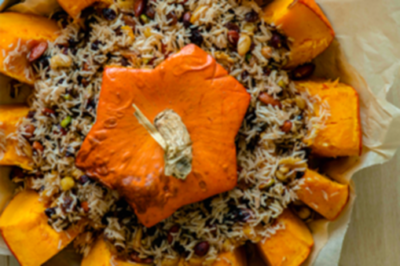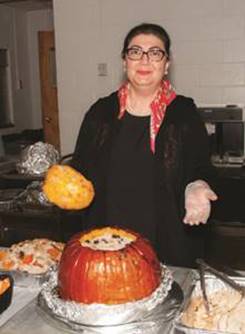Ghapama is a great meatless option for the vegetarians in the family. This recipe and photos are courtesy of Robyn Kalajian at her essential Armenian food blog, thearmeniankitchen.com.
“Ghapama (Armenian: ղափամա) is an Armenian stuffed pumpkin dish, often prepared during the holiday season. It is prepared by removing the flesh of the pumpkin (known as դդում in Armenian, pronounced ddum in Eastern Armenian and ttum in Western Armenian), and stuffing it with boiled rice and a variety of dried fruits such as chopped almonds, apples, corn, apricot, prunes and raisins. It is common to pour on honey and mix in ground cinnamon or sugar. The pumpkin is baked until it becomes soft, and then brought to the table where it is cut up and served.”
“In Armenian, the word ‘ghapama’ literally means cooked in a covered pot. Recipe-wise, ghapama is a stuffed, baked pumpkin traditionally served between the New Year and Armenian Christmas which many Armenians celebrate on January 6,” says Robyn Kalajian, culinary arts teacher and blogger of Armenian cuisine, culture and more. “I was reminded by a friend that there is a traditional song written about this dish re-popularized by Armenian pop singer Harout Pamboukjian titled, ‘Hey, Jan, Ghapama,’” she adds.
“This dish is so Armenian that Armenians have songs written about it. With its vibrant, artistic flair, the dish makes a striking presentation at a dinner or buffet table. The song is often performed in the middle of the celebration or closer to its end, when the guests are already full and want fun. In the song, the singer talks about how there is a wonderful pumpkin in the fields, how they chose it in order to make a ghapama. How they brought it home, filled it with many delicious things. How guests were waiting for it to be ready. And if the hostess prepares everything just right, the ghapama will turn out to be beautiful and appetizing. So appetizing that the hungry relatives will fill their mouths with the aromatic pumpkin. This is exactly what Harout sings about…”*
Watch Harout Pamboukjian’s celebrated 1983 version at: https://thearmeniankitchen.com/ghapama-stuffed-baked-pumpkin-recipe/
“A more formal rendition of this song was performed by the KOHAR Symphony Orchestra and Choir of Gyumri, Armenia,” says Robyn. Watch the orchestra’s Live in Concert from June 2002 at BIEL, Downtown Beirut, Lebanon at: https://www.youtube.com/watch?v=szaojBxz-4Q










